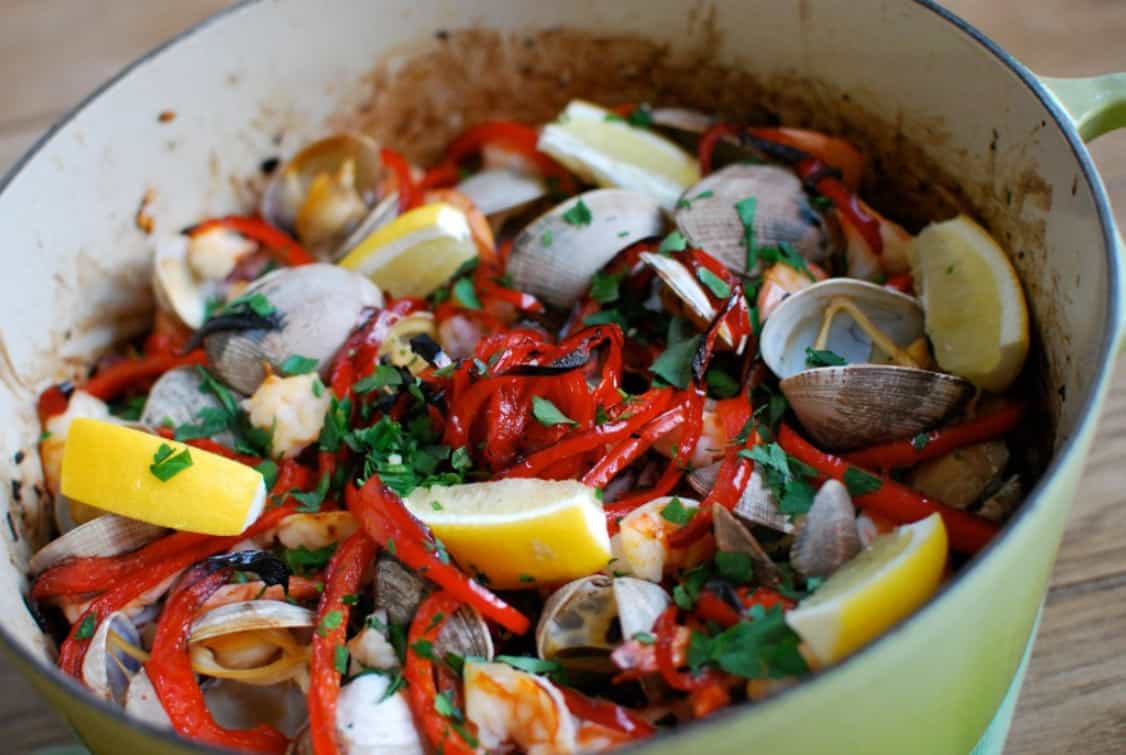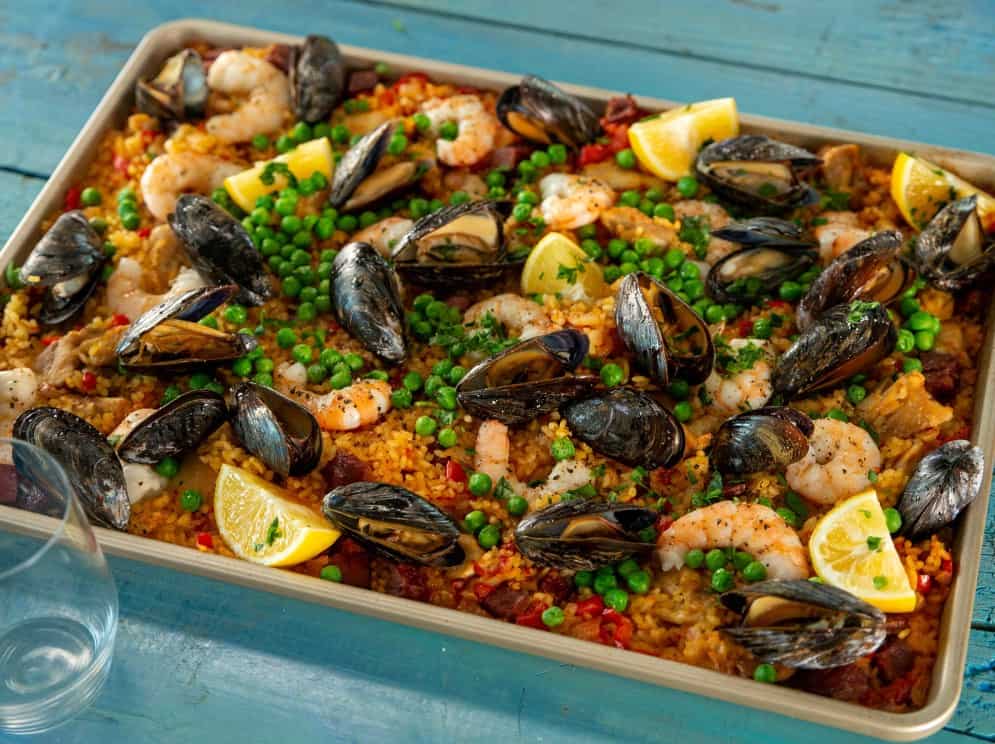In your kitchen, you can’t always have every type of cookware available. There are times when you don’t have the specific and proper tools to cook your desired food. If you don’t own a paella pan, it’s essential to know its substitutes.
Introduction to Paella Pans

If you’ve cooked paella before, you’ve likely encountered the wide and shallow paella pan. This shallow pan is usually made for paella, but it can also be used in searing steaks, chicken cutlets, roasts, and fish fillets.
This flexible cookware can also be used as a griddle for breakfast items such as pancakes, bacon, and eggs. Additionally, it can serve as a substitute for a wok. A paella pan can even work as a stand-in for a roasting pan and even as a tool for cooking over a campfire.
Paella pans are created in this specific shape and style to be as close to the heat as possible. With this design, liquids quickly evaporate, which is the main reason for the golden-brown crust on the bottom of your paella, which many people love.
They are typically made from enameled metal, cast iron, or brushed aluminum. Paella pans typically do not come with a lid because it defeats the purpose of letting liquid quickly evaporate.
A cover will trap moisture, which isn’t desirable for paella. One of the defining features of a paella pan is its handles on both sides, aiding in transferring and plating. While traditional paella pans do not come with a lid, some modern variations may include one.
No Paella Pan? No Problem: Paella Pan Substitutes
You might want to cook paella but unfortunately do not have a paella pan in your kitchen. Would it still be possible? The answer is yes. While paella pans are best for cooking paellas, you can still make good paellas using other cookware that’s readily available in your kitchen.
1. Stainless steel or aluminum skillet

Skillets made from stainless steel or aluminum will work fine in cooking paella. One of the essential things to note is that the skillet should be shallow with a broad base, at least 13 inches in diameter.
If what you’re cooking doesn’t fit in one skillet, don’t hesitate to use two. You would just have to divide the ingredients into two and cook them separately. This way, you are assured that your paella is cooked evenly.
When you decide to opt for skillets as a paella pan substitute, it’s helpful to note that it’s best to avoid non-stick pans and cast iron skillets. Non-stick pans do not add flavor to the dish, and cast iron skillets do not allow heat to escape properly.
2. Dutch Oven

Dutch ovens are great for cooking rich and flavorful rice. A Dutch oven has a heavy base that enables it to toast and cook a layer of rice. However, this cookware fails to deliver the signature crusty, golden-brown socarrat rice at the bottom of the paella.
To achieve the crispy bottom layer, you might consider using the French version of a Dutch oven, known as a cocotte. Cast iron cocotte usually has a lighter base that allows the formation of the desired crispy layer. In cooking paella, it’s important to avoid stirring the mixture as it could be a factor in ruining the crispiness of the socarrat you are trying to achieve.
3. Hotel pans

Perhaps you are cooking for a crowd, and you are planning on cooking considerable amounts of paella. In this case, you might want to consider opting for a hotel pan. You need to cook the ingredients separately before mixing them in one pan. It’s ideal for cooking them in something with a flat base.
More Paella Pan Substitutes You Never Knew You Needed
4. Wok

The wok is also deeper compared to a paella pan and the bottom is not as wide compared to that of a paella pan. However, one notable similarity between the two would be their ability to heat up quickly. On the other hand, paella pans are designed with shallow sides to allow moisture to escape quickly, which does not apply to works.
The differences often lead people to believe that you may be altering the original and the usual recipe, but it would be okay for you to use a wok in cooking paella. There might be changes to the flavor or texture, so it’s essential that you know how to control your ingredients in cases like these. You would want to get rid of any moisture in the food.
5. Shallow Saute Pan

The term “paella pans” refers to a specific style within the broader family of pans. In other words, they share some characteristics that make a saute pan fit as a substitute. A wide, four-quart shallow saute pan with a depth of around 3 inches.
Using a saute pan with at least these dimensions will ensure that flavor does not escape. Saute pans are also equipped with handles, making it all the easier for you to handle the paella recipe.
Shallow saute pans allow moisture to escape, perhaps not as good as a paella pan, but the two are close. Do not close the pan when cooking as this will only trap moisture which is the last thing you would want for your paella. It would be acceptable to cover it after cooking, though. This will help keep the dish warm.
Wait, There’s More!: Paella Pan Substitutes
6. Frying pans

Frying pans can come in many sizes and dimensions, making them an easy substitute for a paella pan. These pans are usually in every household, too, so it’s quite an easy substitute to find.
Your frying pan should be wide, about 10 inches or more in diameter. In using a frying pan, the important thing is not to overcrowd your pan. A smaller pan would also work. However, you would have to cook some ingredients separately to avoid overcrowding.
The cooking process using a frying pan also differs from using an actual paella pan. First, cook the vegetables, seafood, or meat until they reach the desired color, then set them aside in the frying pan.
Next, put in the rice, then allow it to cook in regular heat for 5-6 minutes then, reduce the heat to medium for 3-4 minutes, then increase the heat again for 4-5 minutes. This is key to achieving the crusty taste of socarrat.
7. Rice cooker and a Shallow Pan

This alternative can require more work as you need to work with two separate cookware. You would need to cook the rice in the rice cooker first for this alternative.
In the meantime, work on the meat and vegetables using the shallow pan and set them aside once cooked. After the separate works, it’s time to mix them. You can add a bit of water and let it stay on medium heat to achieve a crusty and toasty bottom of the paella.
Things to Take Note When Cooking Paella
Lids!
First and foremost, for substitutes that have a lid, always ignore their lids. You don’t always need to use them. Lids trap moisture which is always a no-no for a paella dish. You would want to achieve that crusty and crunchy bottom socarrat.
Rice
The preferred rice would be Spanish rice or short grain that absorbs liquid without getting mushy. Remember never to use long-grain rice for paella. Short grain rice absorbs more water before getting all mushy to achieve that dry texture.

Sofrito
This is the aromatic base of paella. This also serves as the foundation of paella’s flavors. This Spanish ingredient is usually green or red peppers, garlic, onions, tomatoes, and olive oil.
Herbs and Spices
Much like any other meal, the use of herbs and spices will elevate your dish. For traditional paella, saffron is the main spice that helps in giving it its rich and golden color. However, saffron is costly, so an alternative would be turmeric or food colorings. Another essential spice would be pimentón or smoked sweet Spanish paprika, and for herbs, rosemary is crucial.
Stock or Broth
Meat-based paella usually uses chicken stock, while seafood paellas use fish stock. Stocks and broth bring additional flavor to your paella, taking it up a notch.
Summary
While cooking paella with a paella pan is ideal, some people do not own one. In this case, it’s best to look for a paella pan substitute. Thankfully, you can cook paella without a paella pan; you would just need to find a suitable replacement for you, work with it, and see what fits your style the most.

Michael Johnson is the founder of Pan Mastery, Inspired by his blacksmith grandfather’s legacy has a deep appreciation for hand-crafted pots and pans, he provides invaluable guides, reviews, and recipes to enhance your culinary journey.

